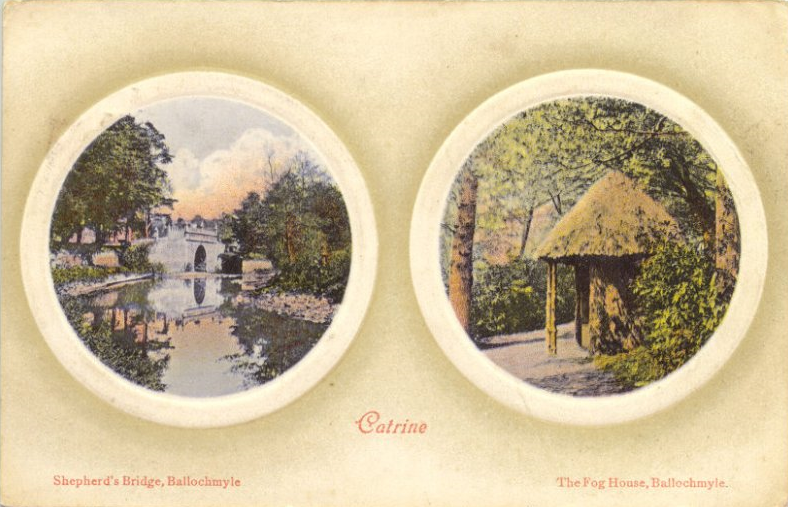Ballochmyle Castle
The name of Ballochmyle is familiar to every admirer of Burns’s poetry, as circumstances connected with the estate gave occasion for the production of two of his finest lyrics — Farewell to Ballochmyle and The Lass of Ballochmyle. One of the retired walks by the river Ayr formed a favourite retreat for the poet whilst he lived in the locality; and many of his most memorable poems were composed within its sequestered shade. Etymologists differ as to the origin of the name, some asserting that the termination refers to an extinct mill [myln) which may have been near the river, and others, with more reason, deriving it from the descriptive Gaelic compound Bealach maol, ” the bare or rocky pass.” The name is not inappropriate when applied to the romantic ravines and bosky dells through which the river takes its way in the vicinity.
The earliest name associated with Ballochmyle, of which any sure trace can be found, is that of Reid, which appears in 1613. The laird at that time was probably a scion of the Reids of Barskimming, and the estate remained in this family until about the middle of last century. It was acquired by the Whitefoords shortly before 1760; but Sir John Whitefoord, the friend and patron of Burns, was compelled, through financial misfortune, to part with the estate in 1 783. The latter circumstance suggested the song of The Braes Ballochmyle, in which the poet represents Maria, the eldest daughter of Sir John — afterwards Mrs Cranston — as lamenting the fate which separated her from the scenes of her infancy :
” Low in your wintry beds, ye flowers,
Again ye ’11 flourish fresh and fair ;
Ye birdies dumb, in withering bowers,
Again ye ’11 charm the vocal air.
But here, alas ! for me nae mair
Shall birdie charm or floweret smile :
Fareweel the bonny banks of Ayr,
Fareweel, fareweel ! sweet Ballochmyle ! ”
The new proprietor was Claud Alexander, the first of that name in Ballochmyle, and the progenitor of the present occupant. He was the third son of Claud Alexander of Newton, Renfrewshire, and was born in 1752. In early life he and his younger brother, Boyd Alexander, entered the Civil Service of the Honourable East India Company, and proceeded to India, where they both amassed considerable fortunes, the elder rising to the position of Auditor-General of Army Accounts, and Paymaster-General. They returned to Scotand together in 1786 ; and whilst Boyd purchased the estates of Southbar and Boghall in Renfrewshire, and became Member for that shire — 1796, and for Glasgow in 1802 — Claud took possession of Ballochmyle, which had been acquired for him during his absence. The latter died in 1809, and was succeeded by his eldest son Claud, at whose demise in 1845 the estate devolved first on one of his brothers, William Maxwell Alexander, and then on the other, Boyd Alexander of Southbar, who died in 1861. The sister of the first proprietor, Miss Wilhelmina Alexander, was celebrated by Burns as the “Lass of Ballochmyle.” The original poem and letter are now at Ballochmyle. The present proprietor is Major-General Claud Alexander, son of Boyd, last named, and Sophia Elizabeth Hobhouse, half-sister of the late Lord Broughton (Sir John Cam Hobhouse). He held a commission in the Grenadier Guards, served during the Crimean War, and has been Member of Parliament for South Ayrshire since 1874; and married, in 1863, Eliza, only daughter of Alexander Speirs, Esq. of Elderslie.
